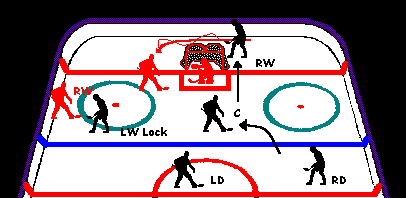

LW LOCK
The LW Lock has been around for years but never received much attention until the Detroit Red Wings made it famous during the 1995-96 season. Some recent claims using the "Lock" are a 50 goals against cut from the year before reports from a highschool coach from St. Louis, MO. In addition, a coach from Ontario, Canada claims a 78 goals against reduction.
Again, there is many variations to the "Lock" so experiment with it to suit your team.
The Lock system is fairly easy to teach. The basics could probably be explained during a 30-second timeout. It allows 2 forecheckers(C and RW) freedom in the offensive zone to go deep, be creative and take chances. They have this freedom because there is always 3 players back in a defensive position for support preventing odd man rushes. The "Lock" also limits breakout space and will force the opposition's defense to carry the puck or bank it up the boards. Since most teams attempt a breakout pass up the boards, the "Lock" should make it almost nonexistent, especially on the offensive RW side.
In the traditional Lock, the LW is responsible for the entire ice surface on his side.
The C and LW were left out in the diagram below.

"Imagine the defensive zone split into left, center and right zones. This is what happens with the left wing lock. The right-d takes the right zone, the left-d takes the center zone, and the left wing, who now covers back to the goal line, takes the left zone," wrote Bill Hines, Hershey Jr. Bears Head Coach on the hockey-coaches list server.
The players do not over lap their designated zones! As you can see, the defensemen now have less ice to cover making their job easier.
Coaches have different theories how "The Lock" is successful for their team. Each coach must adjust the system to work with his or her personnel. The objective is not to be predictable with your system. While the other team is adjusting to your "Lock", you adjust to another variation to stay 1 step ahead. Colorado Avalanche head coach Mark Crawford is a specialist at this technique.
Here's an example of how Pete Belliveau, head coach of a Canadian university explains how his team performs the "Lock".

" The puck is in the offensive zone and the other team's defensemen has it coming around the left wing side (see diagram). He has complete control of the puck."
"Our RW and C (centerman) will pursue and flush him towards the leftwing wall. Our LW is in the LW lane and stays with their RW."
"The play is coming in the neutral zone and our RW and C are pursuing the puckcarrier while our LW is staying with the other team's winger. Our LD stays in the middle lane while our RD stays in the right lane".
"If the offensive RW cuts in front of our two Ds in the neutral zone, our LW will STAY in his lane and pick up anyone who comes in. If the offensive RW cuts behind our two Ds in the neutral zone, then our LW will follow him".
"Once the play comes in our zone it's man on man all over (i.e. 2ds + 1 fwd down low and two fwds on points."
Copyright 2001 Daniel Otten